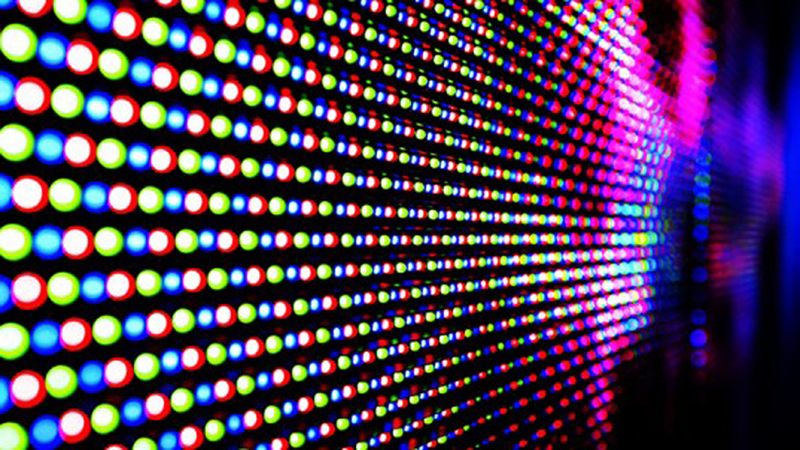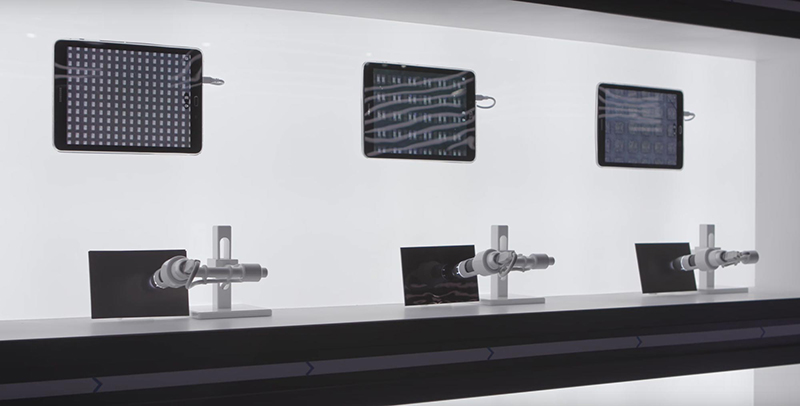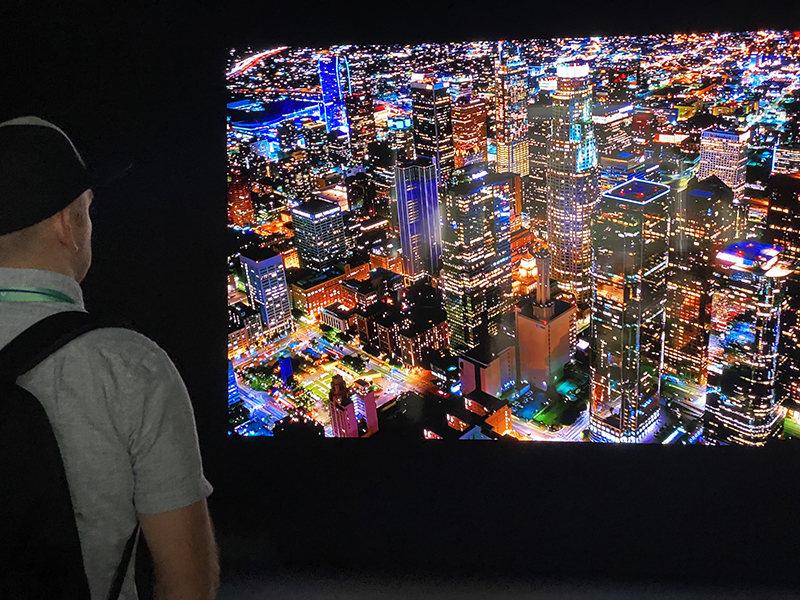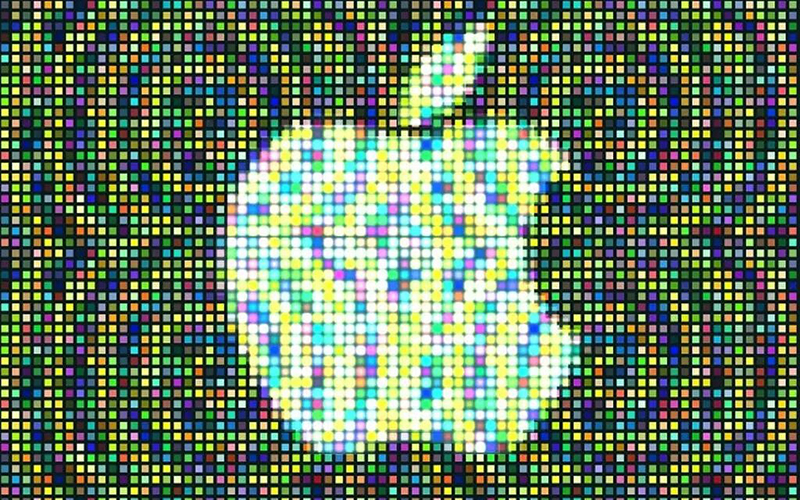What is MicroLED? What's different from OLED? How is the application?
This article will help you learn about MicroLED, differentiate, compare MicroLED and OLED as well as explore its applications on the market today.
1. What is MicroLED?
Also known as mLED or µLED, MicroLED is a flat panel display technology.
MicroLED screens are made up of microscopic arrays of LED bulbs used to form pixels . Each pixel is made up of 3 sub-pixels with 3 primary colors: red, blue and blue (RGB).

Pixels on MicroLED include 3 primary colors: red, blue and blue
Like OLED technology, each pixel in a MicroLED display is self-illuminating without the need for a back-illuminated panel like the LCD screen . This makes MicroLED displays more energy efficient, higher contrast and higher frequency response than LCD monitors.
In addition, these LED bulb arrays are placed on a TFT panel . This panel helps power the screen and controls the brightness of the pixels. By applying this principle, MicroLED technology and OLED technology can create devices to display curved screen TVs.

The sharpness and distribution density of OLED pixels compared to LCD
2. How is MicroLED different from OLED?
In a short period of time, it is possible to judge that MicroLED and OLED screens produce similar image quality and MicroLEDs produce brighter images.
However, considering the structural characteristics, long operating time and prospects in the future, we can see a relative difference between these two technologies.
2.1. The strength of the OLED display
The downside of MicroLED displays is currently the huge strength of OLED displays.
Because MicroLED needs a lot of LEDs to be able to create a high resolution screen, this takes a lot of money and time. In contrast, OLED contains just enough LEDs for a sharp screen. And while existing OLEDs have pixels of different size for different screen sizes, MicroLEDs can only add more pixels of the same size to create larger and higher-resolution televisions.

Module number of conventional LED (left), OLED (center) and MicroLED (right)
Besides the manufacturing factor arguably the most important advantage of OLED, the technology also has an infinite contrast ratio, perfect blacks, excellent viewing angles, and an extremely bright display. It can be said that OLED is a pretty or even great choice in the price range, until MicroLED can fix the flaws when it comes to large resolutions like television.
2.2. The strengths of MicroLED displays
However, in the future, the MicroLED screen is completed and will make a huge difference.
The reliance on organic compounds of OLEDs leads to "deterioration in brightness over time". Worse still, when OLED screens are used for a long time, some compounds are more likely to lose brightness faster than others, producing uneven images.

MicroLED displays are thin and sharp to every detail
On the contrary, LEDs in MicroLED will only get brighter and brighter only day by day due to no natural degradation. In the long run, MicroLED is capable of preserving image quality and maintaining outstanding brightness and possessing much higher energy efficiency than OLED.
Last and foremost, MicroLED's mechanism of action allows for the production of sharp, yet incredibly thin and delicate displays. This promises to be the future advanced production and display trend, pursued by many technology companies.
3. Application of the MicroLED display
Although it has appeared on the market since 2014, MicroLED technology is still being applied and developed by technology giants such as Apple, Samsung , LG, . According to experts, MicroLED can will make a huge breakthrough in image quality and screen thinness in the future.

Apple, LG, Samsung, . are the silent big boys in the MicroLED race
Most of the current microLED technology is only in the stage of research, testing and display, but has not officially been commercialized on the market. However, there are also contributions from: Sony's' Crystal LED 'display in 2012, Samsung's CES 2018 event and the 146-inch' The Wall 'television, 173' microLED screen of LG, . In addition, the big Apple is also incubating to integrate this technology in the Apple Watch format .
We also have the right to hope that a MicroLED TV with an ultra-thin, sharp, durable screen will appear in the near future.

Samsung's "The Wall" TV launched in 2018
Above is the article about MicroLED, distinguishing MicroLED from OLED and the applicability of this technology. The Gioi Di Dong hopes to provide readers with useful and quality information.
You should read it
- Apple canceled plans to launch Apple Watch Ultra MicroLED due to high costs
- What is evo OLED panel? What's different from OLED?
- What is QD-OLED? Why is QD-OLED better than OLED or LCD TV?
- Europe may ban 8K TVs because they consume electricity
- Should I buy a QLED, OLED or LED TV?
- 6 best OLED laptops 2023
- Samsung's new durable OLED screen passes the test of being hammered
- Difference between QLED and OLED TV
May be interested
- Should I buy a QLED, OLED or LED TV?
 when shopping for a tv, you'll see qled, oled, and led options. they all seem to look the same when you see them on screen, so which tv should you buy and what are the differences between them?
when shopping for a tv, you'll see qled, oled, and led options. they all seem to look the same when you see them on screen, so which tv should you buy and what are the differences between them? - Done, Samsung and LG will be the makers of OLED displays for the iPhone
 apple will have a second oled display supplier.
apple will have a second oled display supplier. - What is Tandem OLED on the new iPad Pro M4?
 interestingly, the ipad pro 2024 has the highly anticipated oled display which apple calls 'tandem oled'. since this term is not very common, many people may wonder what it is and how it makes the new ipad pro special.
interestingly, the ipad pro 2024 has the highly anticipated oled display which apple calls 'tandem oled'. since this term is not very common, many people may wonder what it is and how it makes the new ipad pro special. - Asus Zenbook OLED - The Top Laptop Line from Asus
 asus zenbook oled - with impressive design, powerful performance and full hn screen. so what are the advantages of asus oled laptops? should you invest now?
asus zenbook oled - with impressive design, powerful performance and full hn screen. so what are the advantages of asus oled laptops? should you invest now? - LG Display presents 65-inch scrollable OLED TV like paper
 this is a 4k tv that can be rolled up like a high-tech newspaper.
this is a 4k tv that can be rolled up like a high-tech newspaper. - Europe may ban 8K TVs because they consume electricity
 new technology tvs such as microled and oled with 8k resolution will have to comply with some limits on electricity consumption in the european market.
new technology tvs such as microled and oled with 8k resolution will have to comply with some limits on electricity consumption in the european market. - Samsung Galaxy S21 will likely use the Chinese manufacturer's OLED panel, no longer 120Hz
 some galaxy s21 models will feature oled panels manufactured by chinese company boe, instead of using samsung display's oled panels.
some galaxy s21 models will feature oled panels manufactured by chinese company boe, instead of using samsung display's oled panels. - Samsung's new durable OLED screen passes the test of being hammered
 in the video, the screen panel, despite being hit hard several times with rubber hammer, is still unharmed.
in the video, the screen panel, despite being hit hard several times with rubber hammer, is still unharmed. - What is Neo QLED? Is it better than QLED and OLED?
 neo qled is one of the latest display technologies for tvs. samsung has already adopted the technology in 2021 for its entire lineup of 4k and 8k tvs, promising a huge improvement in picture quality over traditional qled displays.
neo qled is one of the latest display technologies for tvs. samsung has already adopted the technology in 2021 for its entire lineup of 4k and 8k tvs, promising a huge improvement in picture quality over traditional qled displays. - Samsung will have laptops with OLED displays by the end of 2010
 with the advantages of slim, good display and less power consumption, oled displays are very suitable for laptops
with the advantages of slim, good display and less power consumption, oled displays are very suitable for laptops










 Common error codes of induction cookers
Common error codes of induction cookers Do you really know how to use the fridge? Answer these questions to know the truth
Do you really know how to use the fridge? Answer these questions to know the truth How to install the Wyze Cam
How to install the Wyze Cam How to troubleshoot common refrigerator problems
How to troubleshoot common refrigerator problems Anker Eufy Homevac H11 handheld vacuum cleaner, top choice for small room cleaning.
Anker Eufy Homevac H11 handheld vacuum cleaner, top choice for small room cleaning. 9 surprising Alexa tricks to try with your Amazon Echo tonight
9 surprising Alexa tricks to try with your Amazon Echo tonight